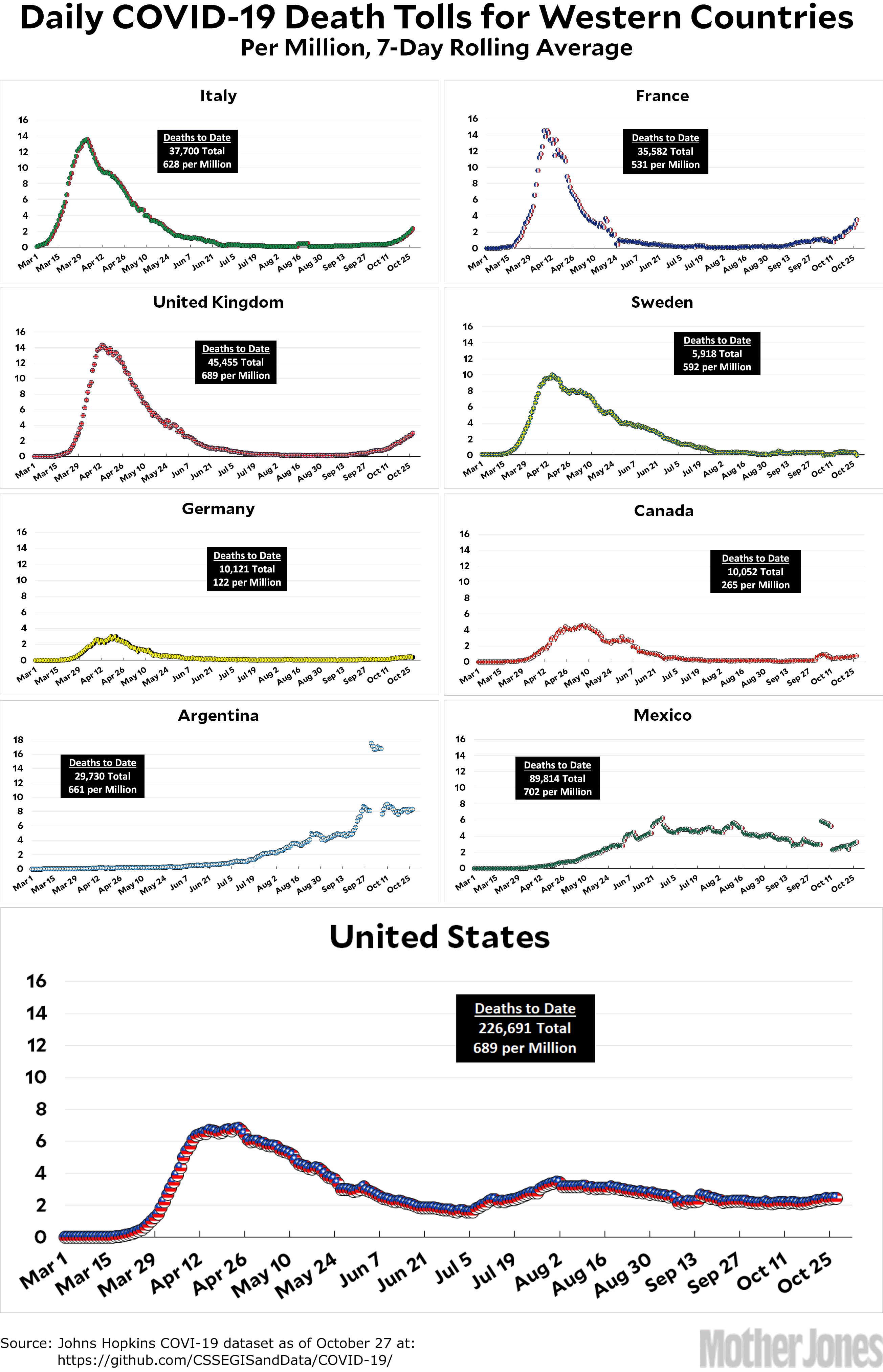When I went outside to check on this, it turned out there was an entire cat attached to this tail. Truly one of the miracles of our age.


When I went outside to check on this, it turned out there was an entire cat attached to this tail. Truly one of the miracles of our age.

Here’s the coronavirus death toll through October 29. The raw data from Johns Hopkins is here.
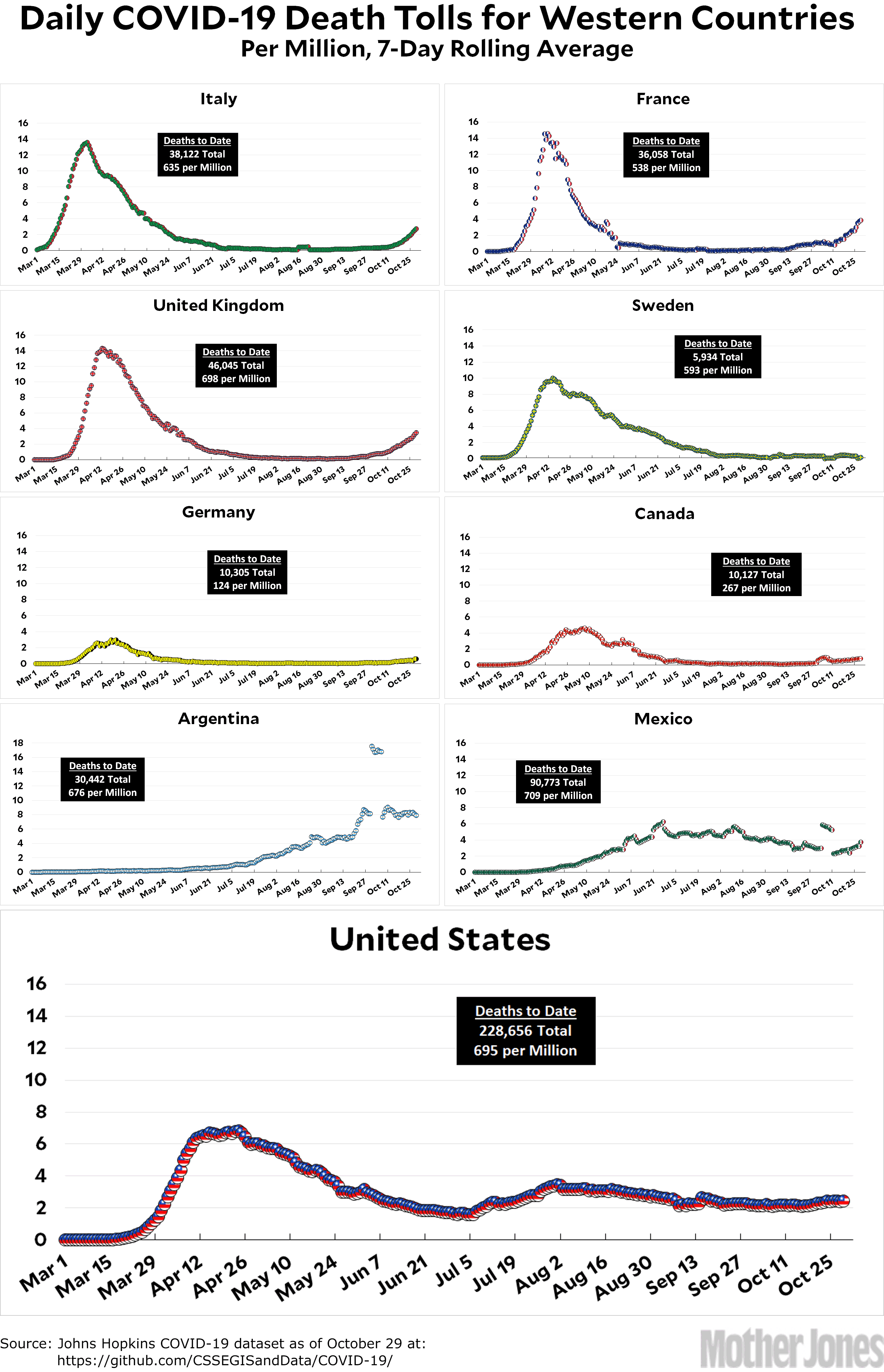
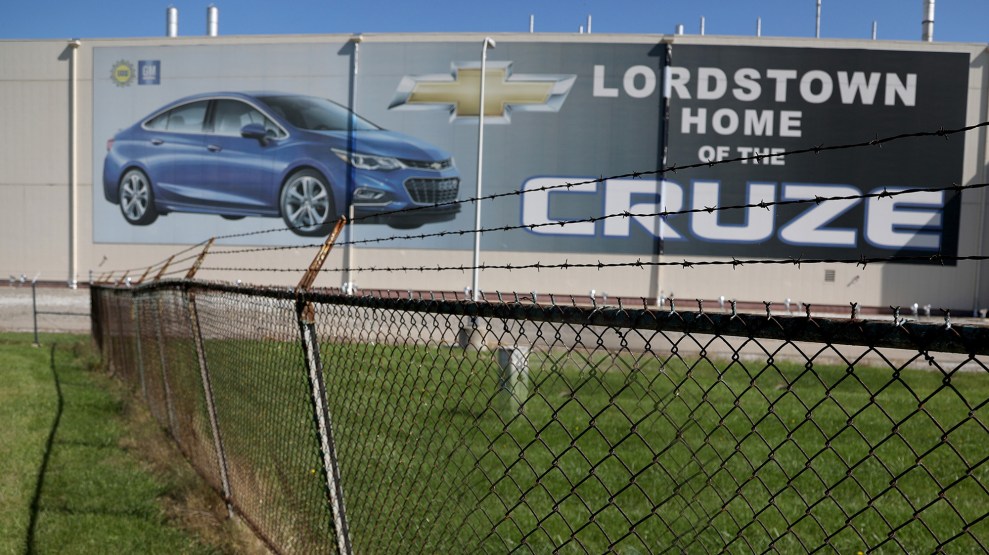
TNS via ZUMA
A couple of years ago General Motors announced that it was closing its assembly plant in Lordstown, Ohio. The Guardian has a nice piece today about how Donald Trump’s support is holding up there. There’s this:
In July 2017, Trump spoke in Youngstown and told the crowd that on his way in from the airport, he had seen the carcasses of too many factories and mills. He bemoaned Ohio’s loss of manufacturing jobs, but then boldly assured the crowd: “They’re all coming back!” He next told his audience, many of them workers worried about plant closings: “Don’t move! Don’t sell your house!”
Laid-off GM Lordstown workers still rail about that speech. Many moved to other cities to find work; many lost money selling their homes….Tammy Vennetti voted for Trump in 2016, largely because her older sister, a retired GM worker, kept urging her to….She is still fuming about his do-not-sell-your home remarks in Youngstown” “He promised that nobody was going to have to sell their homes. He said they [GM] were going to stay. That’s why I can’t vote for him this year.”
And this from Dave Green, a union official:
Soon after taking office, Trump relaxed fuel-efficiency standards for cars, and that, Green realized, could doom the plant, which made compact, fuel-efficient Chevy Cruzes. “He wasn’t in office long before he announced he would do away with the Cafe [Corporate Average Fuel Economy] standards,” Green said. “Auto manufacturers here had to build so many small cars to balance for all the SUV’s. When Cafe went away, Trump did the workers of Lordstown a huge disservice.” He doesn’t blame Trump for the plant closing, but says Trump accelerated GM’s decision, noting that GM much preferred building SUV’s and trucks to lower-profit small cars.
But there’s also this:
Mike Yakim, who worked as a team leader in Lordstown’s paint department, also backed Trump in 2016 and remains a big fan. “I had my reservations about him. I know he’s not a saint,” Yakim said. “But I had a good feeling about him. Trump seemed to be for the little guy.”
….“I saw what Biden has done to the economy, what he’s done in 47 years in office: his support of Nafta, that pretty much gutted the auto industry, and his rallying for the TPP [Trans-Pacific Partnership].” He asks why Biden didn’t do more to stop GM from closing its Wilmington plant in 2009 or stop Chrysler from shutting its plant there in 2008.
Anyway, it’s a good look at a cross section of working-class voters who are both for and against Trump. It’s worth a read.
If I have identified this bird correctly, it’s a white-fronted bee eater at the San Diego Zoo. It doesn’t look very white fronted to me—more like white throated, maybe—but I’m not the person who names things.

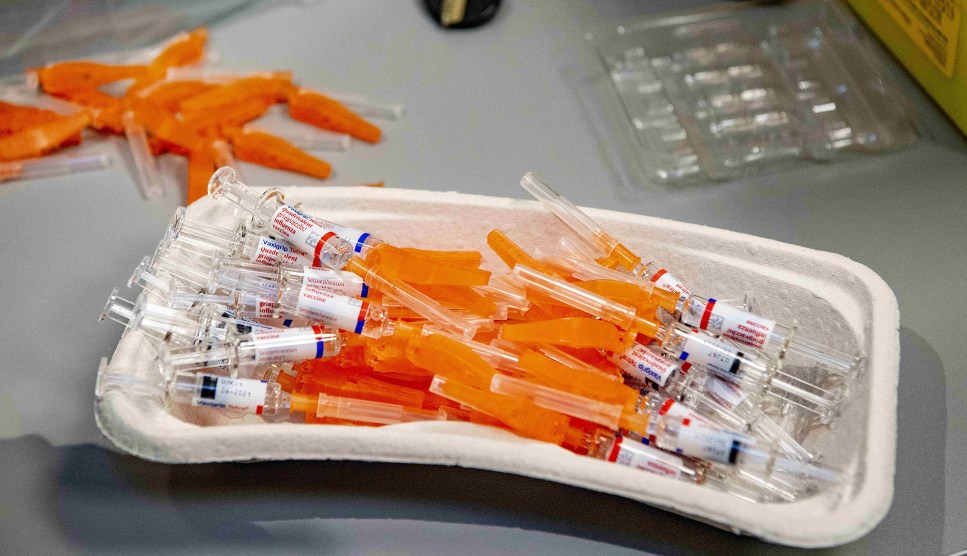
This is actually flu vaccine, but you get the idea.Ddp Images/DDP via ZUMA
How fast should we approve a new COVID-19 vaccine? Tyler Cowen argues that sooner is better if a vaccine shows even moderate promise. Even if the vaccine is imperfect, the number of lives saved by an early release is almost certain to be greater than the number of lives lost to unforeseen side effects.
I think this is true, but I’d still hesitate to release a vaccine too early. In the short term, maybe it would be a net positive. But in the long term, people will react strongly to even a modest number of deaths from the vaccine. The worst possible scenario would be one in which we finally develop a safe, effective vaccine, but large swaths of the public refuse to get it because previous trials led to enough deaths to become newsworthy.
The basic argument for approving a COVID-19 vaccine as soon as possible is sound, but success or failure will depend almost entirely on gaining public acceptance for it. Even if it means delaying approval, this really needs to be our primary concern.
In the meantime, it does look as if the schedule for a vaccine is slowing:
The ambitious drive to produce Covid-19 vaccine at warp speed seems to be running up against reality. We all probably need to reset our expectations about how quickly we’re going to be able to be vaccinated. Pauses in clinical trials to investigate potential safety issues, a slower-than-expected rate of infections among participants in at least one of the trials, and signals that an expert panel advising the Food and Drug Administration may not be comfortable recommending use of vaccines on very limited safety and efficacy data appear to be adding up to a slippage in the estimates of when vaccine will be ready to be deployed.
Asked Wednesday about when he expects the FDA will greenlight use of the first vaccines, Anthony Fauci moved the administration’s stated goalpost. “Could be January, could be later. We don’t know,” Fauci, director of the National Institute of Allergy and Infectious Diseases, said in an online interview with JAMA editor Howard Bauchner.
Here’s the coronavirus death toll through October 28. The raw data from Johns Hopkins is here.
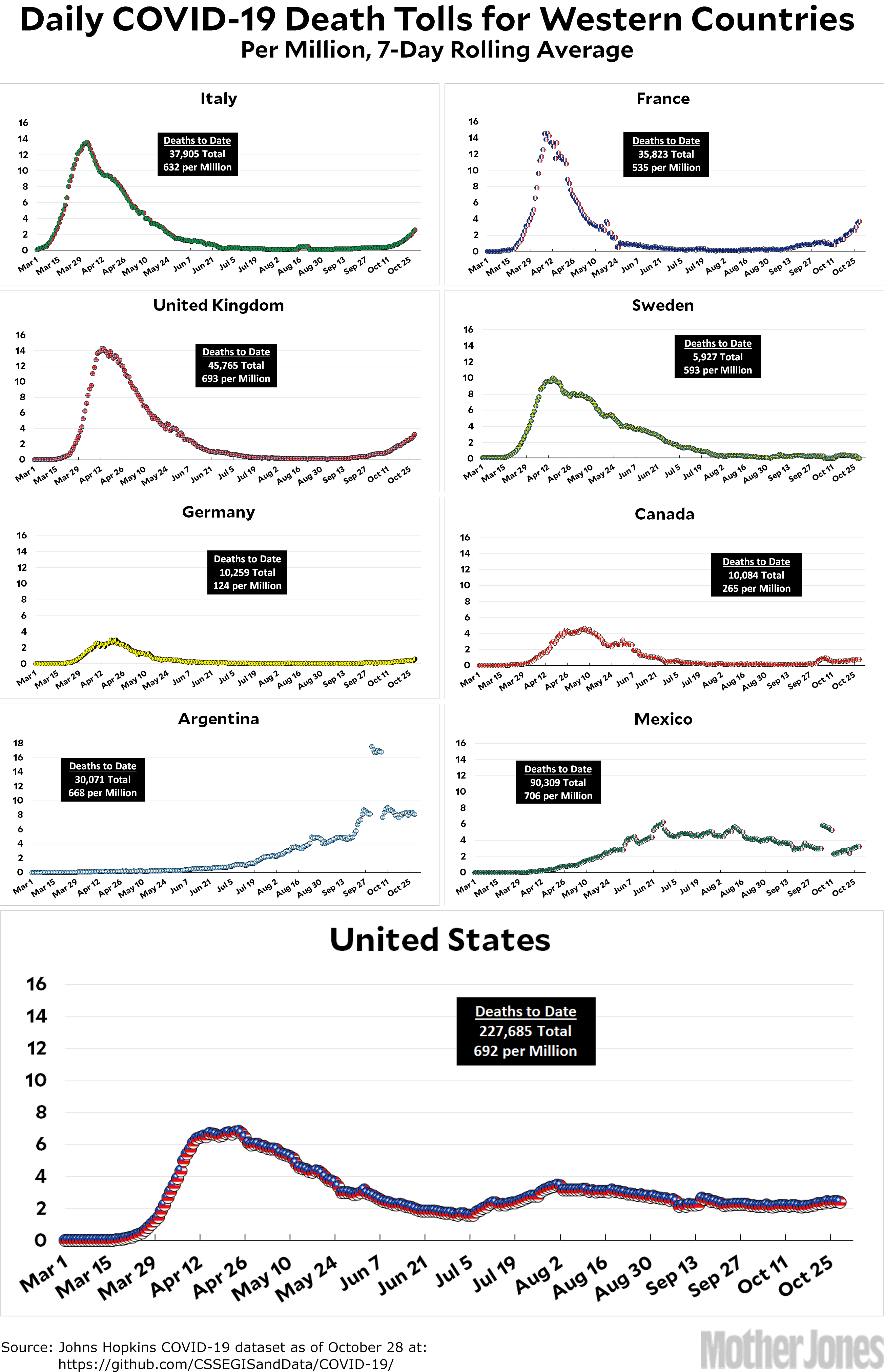
No surprises today: GDP in the third quarter grew significantly:
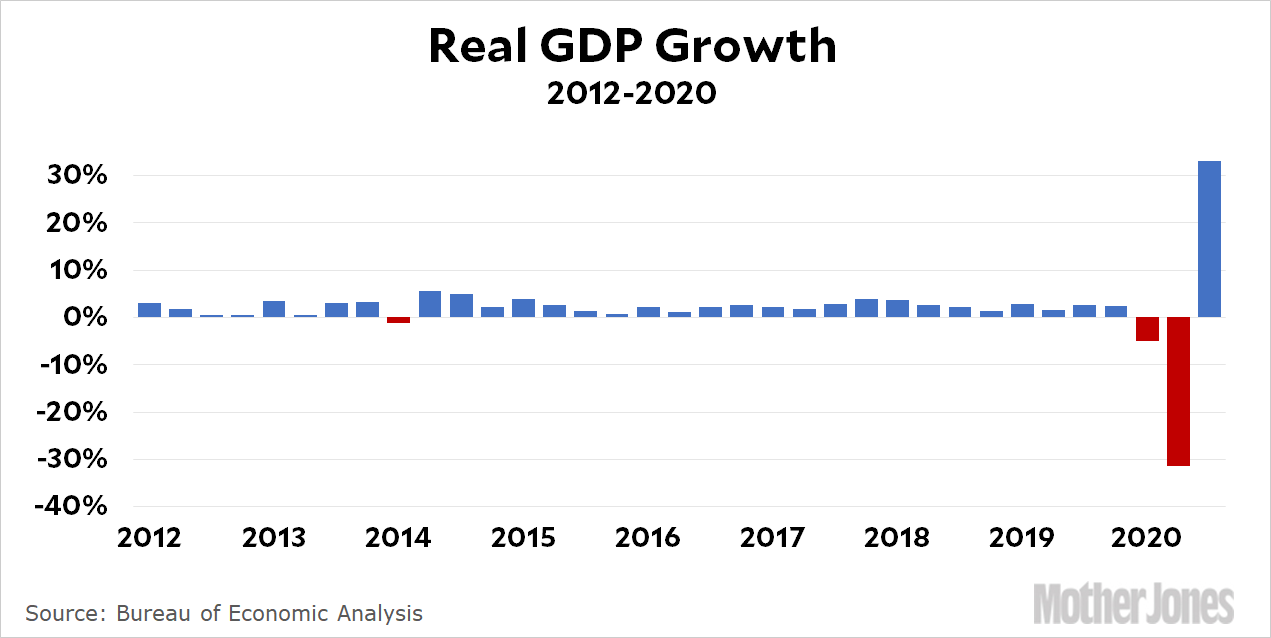
The chart above is the normal look at GDP growth, but since the last two quarters featured such unusual behavior it might be better to take a different kind of look:
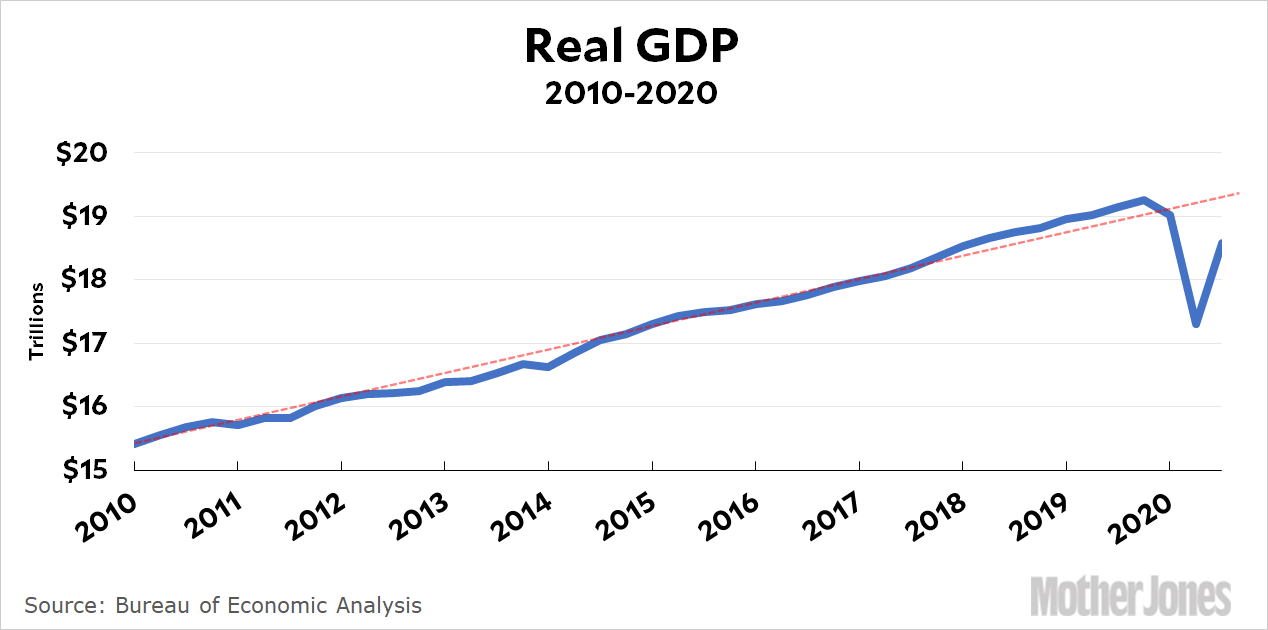
Give or take a bit, we’re still about $1 trillion below where we’d otherwise be, so the effects of the coronavirus are very definitely still with us.
In other news from the BEA release, personal income was down by half a trillion dollars and personal savings were down by $2 trillion. The drop in income was due to the end of pandemic relief programs, and the drop in savings was due to families drawing down their savings to make up for lost income. Roughly speaking, families used part of the money from the CARES Act to bolster savings and then started spending it down when that assistance ended.
The Q3 increase in GDP was driven entirely by the private sector, led by big increases in purchases of durable goods and commercial equipment. The federal government did nothing to help, decreasing its spending thanks to the end of the CARES Act.
I’ve been out all day with a mystery illness, but now I’m back. I think. I won’t know for sure until morning.
Just in case I’m not, a quick note: We’ll be getting the 3rd quarter GDP estimate on Thursday morning. Since GDP dropped something like 30 points last quarter, it’s inevitable that it will rebound by 20 points or more this quarter. Donald Trump is sure to call this the “biggest GDP gain in history” or some such, but obviously it’s no more meaningful than last quarter’s decline. Both are artificial results of government shutdowns and tell us nothing about the underlying economy. At this point, GDP growth isn’t much more than a measure of how much of the economy has been allowed to reopen.
This is a foggy morning picture of an elevated freeway down at the Port of Long Beach. But which one? It might be Interstate 710 or it might be California 47. In fact, thinking about it a bit more, it’s probably the 47, and the viaduct on the far right is for rail traffic. But I’d have to go back there to be sure.

Here’s the coronavirus death toll through October 27. The raw data from Johns Hopkins is here.
